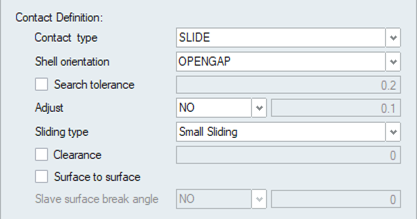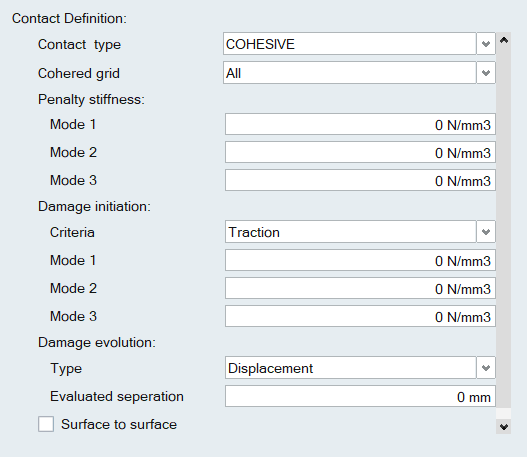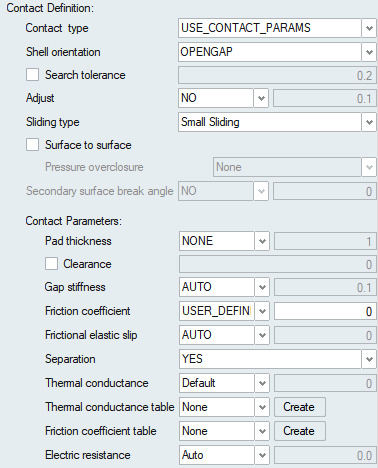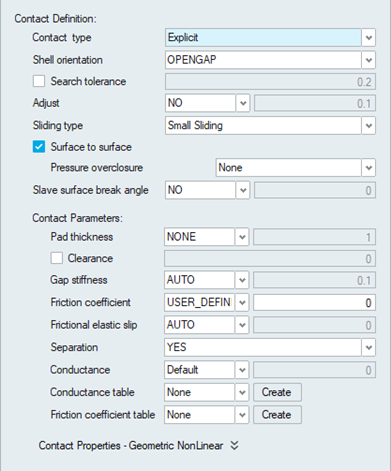OptiStruct Contact Parameters
Following method of contact can be defined.
- Face-Face
- Edge-Edge
- Self-Contact
- General

- Contact Type: Used to define contact method - Slide/Stick/Freeze/Contact Property/Tie/Explicit/Cohesive.
- Shell Orientation: Used to set the Orientation of contact force from master surface.
- Search Tolerance: Used to specify the search distance for defining the contact condition between master and slave surface elements. When specified only slave nodes that are within this distance from master surface will have contact condition established. If search tolerance is not given, OptiStruct will consider all the nodes of the slave surface for contact analysis.
- Adjust: Used to adjust the slave nodes onto the master surface at the start of a simulation.
- Sliding type: Used to control the relative sliding distance between master and slave elements.
- Slave surface break angle: Used to break the slave surface into several patches to do corner treatment. It is supported for both N2S (only for Continuous sliding) and S2S contacts.
- Cohesive contact:Used to model cohesive zone easily by eliminating
the need to mesh and setup the cohesive elements.

- Cohered grid:Used to define cohesive contact zone.
- Penalty stiffness:Used to define the material properties of damage-based cohesive material models.
- Damage initiation: Used to define damage initiation criteria(Traction/Strain/Quadratic form of traction/Quadratic form of strain) and corresponding values.
- Damage evolution:Used to define damage evolution type(Displacement/Energy dissipation) and the respective values.
- Contact Property Parameters:

- Pad Thickness: Used to consider additional material layers covering master or slave surfaces. User defined values can be specified or THICK option can be specified which will consider the shell thickness defined in the element property.
- Clearance: Used to specify the clearance between master and slave surfaces. For USE_CONTACT_PARAMS and EXPLICIT, clearance can be specified only if pad thickness is none.
- Gap Stiffness: Used to defined the stiffness of the elements involved in the contact. OptiStruct will calculate the stiffness based on the stiffness of surrounding elements if AUTO is specified. SOFT can be used in cases of convergence difficulties and HARD can be used if undesirable penetration is detected in the solution.
- Friction Coefficient: Used to specify friction conditions between contact surfaces. It can be STICK / FREEZE / User defined friction coefficient.
- Frictional elastic slip: Distance of sliding up to which the frictional transverse force increases linearly with slip distance.
- Separation: Flag indicating whether the master and slave can separate after the contact has been closed.
- Conductance: Used to specify the conductance value between contact surfaces. It can be Default / AUTO / User defined value.
- Electric Resistance: Used to specify the resistance value between contact surfaces. It can be Default / Auto / User defined value.
- Pressure Overclosure Parameters: These parameters are used to specify non linear penalty parameters for contact (Exponential and Quadratic penalty curve).These parameters can be specified only for Surface to surface contact.
- Friction coefficient table: Used to specify friction coefficient value variation with respect to time / frequency.
- Explicit Contact Type: Defines the properties of
general (PCONTX) and type 24 (PCNTX24) of a CONTACT interface for geometric
nonlinear analysis.
